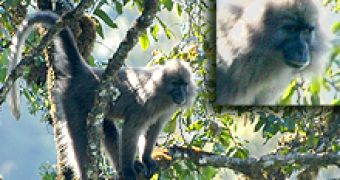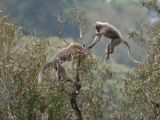A new African monkey, named Kipunji, was photographed last year. But now one of these monkeys was caught in a farmer's trap and died. A team of scientists, organized by Tim Davenport of the Wildlife Conservation Society in Tanzania, examined the monkey's physical characteristics, analyzed its DNA and concluded that Kipunji is so different from what is already known that it belongs to an entirely new genus. (A genus is a group of related species.)
"I was very skeptical of the need for a new assignment when I first saw a photo of the animal - because it looks like a mangabey," said Eric Sargis, Assistant Professor of Anthropology at Yale, and co-author on the study. "But such appearances have been misleading in the past."
The DNA analysis has shown that its closest relatives are the savanna baboons in the genus Papio, even though Kipunji now lives in forest and spends much of its time in trees. The team placed Kipunji in its own genus Rungwecebus, named after Mt. Rungwe where Kipunji was first observed. The monkey is thus now called Rungwecebus kipunji - pronounced rhung-way-CEE-bus key-POON-gee.
"To find, in the 21st Century, an entirely new species of large monkey living in the wild is surprising enough. To find one that can be placed in a new genus, and that sheds new light on the evolutionary history of the monkeys of Africa and Eurasia as a whole is truly remarkable," said John F. Oates, Professor of Anthropology at Hunter College and a renowned primatologist. "This discovery also reinforces the view that mountains in southern Tanzania have played an important - and until recently unexpected - role as a refuge for many species long extinct elsewhere."
"Finding a new genus of the best-studied group of living mammals is a sobering reminder of how much we have to learn about our planet's biodiversity," said study team member Link Olson, the Mammals Curator at the University of Alaska Museum.
The monkeys have light-to-medium grayish brown fur, with off-white fur on the belly and the end of their long, curled-up tail. They have a "crown" with a very broad crest of long, erect hair. Adults make a distinctive, loud, low-pitched call described by the scientists as "honk-bark". Kipunji is an omnivore, eating shoots, leaves, flowers, bark, fruit, lichen, moss and invertebrates.
Predominantly tree-dwelling, the monkeys and are known to live in only two high-altitude locations at about 2500 meters above sea level: the Rungwe-Livingstone forest and Ndundulu Forest Reserve in Tanzania. They live in social groups of 30-36 adult males and females. Their main predators are crowned eagles and possibly leopards, but humans also (illegally) hunt the monkeys for meat.
It is estimated that only about 500 Kipunji monkeys are left in the wild, living in less than twenty groups. The animals will probably be classified as "critically endangered," the researchers write, and quick action is required if they are to survive.
Photo credit: Tim Davenport/The Field Museum

 14 DAY TRIAL //
14 DAY TRIAL // 
